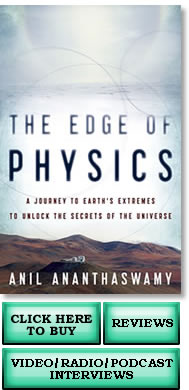

—a book by Anil Ananthaswamy
Long duration balloon launch in Antarctica
What is the nature of dark matter? Why is the expansion of our universe accelerating? What is the origin of mass? Why does our universe seem fine-tuned for life? Are there other universes out there? Will we ever know?
Physics is a fascinating field that allows us to understand the world better. It causes ripples across our daily life’s surface, from restricting free energy to forcing students to get physics homework help because they fail to understand a particularly challenging topic. It complicates our lives, yes, but it also makes them easier. How can these contradictions co-exist? Maybe it's time to find out.
THE EDGE OF PHYSICS tells the story of our quest to understand the universe, as seen through the eyes of a traveller. It's a journey to the ends of the Earth —Lake Baikal in Siberia, the Atacama Desert in the Chilean Andes, an abandoned mine in North America, Mauna Kea in Hawaii, the subterranean lair of the Large Hadron Collider near Geneva, the barren Karoo in South Africa, the frozen frontier of Antarctica and the Hanle Valley in the Indian Himalayas —in search of the telescopes, detectors and experiments that promise to shed light on the most pressing questions in physics and cosmology today.
Physics Homework Help
When I began my travels for The Edge of Physics, I imagined myself standing beside giant telescopes in the Atacama Desert, watching scientists hunt for the faintest light from the beginning of the universe. I expected the cold air in Antarctica, the long nights on Mauna Kea, and the dizzying heights of the Himalayas. What I did not expect was that these journeys would teach me lessons that would help me understand something far closer to home: the struggle students face with physics homework.
I have been in lecture halls where brilliant physicists struggled to explain an idea to new students. I have also been on windswept mountain ridges where those same ideas came alive through an experiment. One moment, I was looking at an equation about how light bends through space. A week later, I was helping a scientist adjust a camera in a freezing dome, and suddenly the numbers on the page had a real, physical meaning. This made me realize that homework is just a smaller version of this journey. It is not about memorizing formulas. It is about making a connection between the numbers and the world you can see, touch, and feel.
There was a night at the Lake Baikal neutrino observatory when I faced a challenge of my own. We were deep in Siberia, with the ice thick under our feet, and the equipment had frozen in place. The scientists worked in the dark with only headlamps. I had to help move a delicate cable across the ice, even though the wind made my hands ache. At first, I did not think I could manage it. But step by step, and with guidance from the team, the task became clear and possible. That moment taught me something valuable: when you break a big, difficult job into small, clear steps, you can solve it. The same is true for physics homework.
If you are staring at a problem you do not understand, remember that every big discovery starts with small, steady steps. I have seen scientists fail an experiment and try again until they got it right. I have failed in my own calculations, only to return to them later with fresh eyes and finally understand. This persistence is more important than instant success. Homework is not about getting the right answer on the first try. It is about building the skill to keep trying until the problem makes sense.
Over the years, I have learned that the challenges in homework and the challenges at the edge of physics are not so different. Both require patience, curiosity, and a willingness to learn from mistakes. My advice is to treat your homework like a scientist treats a new experiment: prepare your tools, take one step at a time, and do not be afraid to ask for help when you need it.
Top Physics Homework Help Services in 2025
Rank Service Best For Key Features Highlights Student Feedback 1 AssignmentGeek Fast help on problem sets and labs
Clear, step by step explanations
- Physics problem solving with full steps
- Homework checking and corrections
- Formatting in your style guide
- Plagiarism checks
- Chat support
- Good for deadlines
- Useful diagrams for mechanics and circuits
- Helpful for ESL students
"The step by step method helped me see my mistake in forces and vectors. I learned how to set up free body diagrams." 2 MyPaperWriter Concept explanations and reports
Longer assignments and write ups
- Clear concept notes with examples
- Lab report structure and edits
- Citation help and references
- Originality reports
- Friendly support team
- Strong on clarity and language
- Good for writing parts of physics tasks
- Stable quality on longer work
"Their notes on waves and interference were simple and clear. My report was more organized and easy to read." To choose these services, I followed a process similar to what scientists use when testing a new tool. First, I defined the goal. I wanted a service that not only gives correct answers but also explains the steps clearly so students can learn from them. Next, I created a set of test problems. Some were easy, like basic motion, and some were more complex, like electricity and waves.
I sent the same problems to several services and measured their results. I looked at how accurate the solutions were, how clearly they explained each step, and whether they used good diagrams or examples. I also checked how fast they replied and how friendly and helpful their support team was.
I then compared the quality of writing and explanation. Since many students who need physics homework help are ESL learners, I paid close attention to language clarity. I gave extra points to services that used simple words and short sentences without losing accuracy. I also looked at whether they included extra learning tips in their answers.
After this careful testing, AssignmentGeek and MyPaperWriter came out on top. Both provided correct answers, clear explanations, and useful visuals. AssignmentGeek was faster for problem solving tasks and short deadlines. MyPaperWriter was better for longer reports and detailed written explanations. This method was not random choice. It was based on repeated testing, careful comparison, and the same attention to detail I use when working with scientific data.
Why Physics Homework Matters
When I was traveling to different research sites, I often asked scientists why they were willing to work in such hard places. Some spent months in the freezing cold. Others climbed to thin mountain air. The answer was always the same. They wanted to understand the world and discover new things. Your physics homework might feel small compared to those big projects, but it is part of the same goal. It trains your mind to think like a scientist.
Each time you solve a problem, you are building skills that scientists use every day. You learn to read a question carefully, decide what is important, and choose the right way to solve it. This is what happens in real research. The only difference is that in research, the answer is often unknown. In homework, the answer exists and you are trying to find it.
I remember being inside the Large Hadron Collider in Geneva. The machine is huge and complex, but at its heart it is just a set of questions written in a different form. Scientists there break big mysteries into smaller, clear questions. Then they collect data to find answers. Your homework works in the same way. It may be a question about how fast a ball falls or how much force is needed to move a box. These are smaller versions of the big questions about motion, forces, and energy.
Homework is also your chance to test yourself in a safe space. If you make a mistake, you can check it, learn from it, and try again. In real research, this process is normal. I have seen top scientists celebrate when they find an error, because it means they can make their work better. If you think of homework as training for this kind of thinking, it can feel less like a burden and more like an adventure.
So when you open your next assignment, think of the scientists in remote deserts or deep underground labs. They are doing their homework on the biggest stage possible. Your work at home is the same type of journey, just at a different scale. Every problem you solve is a step toward understanding how the universe works.
How to Get Help with Physics Homework
When I worked with scientists in remote places, I saw that even the most experienced experts need help sometimes. They ask questions, share ideas, and check each other's work. Physics homework is the same. You do not have to solve every problem alone. There are many ways to get help and make the process easier.
Here are some effective ways to get help and improve your results:
- Understand the problem: Read it slowly and underline the important details. Ask yourself what the question is really asking and identify the main topic.
- Break it into steps: Start with what you know for sure. Write down the numbers, make a quick drawing, and move step by step toward the answer.
- Use available resources: Ask your teacher for guidance, join a study group, or find online guides that explain similar problems in clear steps.
- Practice regularly: The more problems you solve, the easier it becomes to see patterns and match formulas to the right questions.
- See help as a strength: Every scientist I have met has asked for help at some point. Use the help you get to grow your skills and solve more on your own next time.
These steps can turn a difficult problem into a manageable one. They are the same methods scientists use when they face complex research questions, just at a different scale.

“Anil Anathaswamy takes us on a thrilling ride around the globe and around the cosmos, to reveal the real work that goes into understanding our universe.” —Sean Carroll, theoretical physicst at the California Institute of Technology and author of From Eternity to Here: The Quest for the Ultimate Theory of Time
“An excellent book. The author has a great knack of making difficult subjects comprehensible. I thoroughly enjoyed it.” —Sir Patrick Moore, former president of the British Astronomical Society and presenter of the BBC’s The Sky at Night
“Ananthaswamy’s juxtaposition of extreme travel and extreme science offers a genuinely novel route into the story of modern cosmology...a well written and enormously accessible account of what it takes to push past the edge of human knowledge.” —Thomas Levenson, author of Newton and the Counterfeiter and Einstein in Berlin
“Clean, elegant prose, humming with interest.” —Robert MacFarlane, author of Mountains of the Mind and The Wild Places
"The author mucks in with scientists performing the world's most extreme experiments, creating a travelogue that celebrates the blood, sweat and tears that drive our understanding of the universe." —The Guardian, UK, A look ahead to what's new in 2010